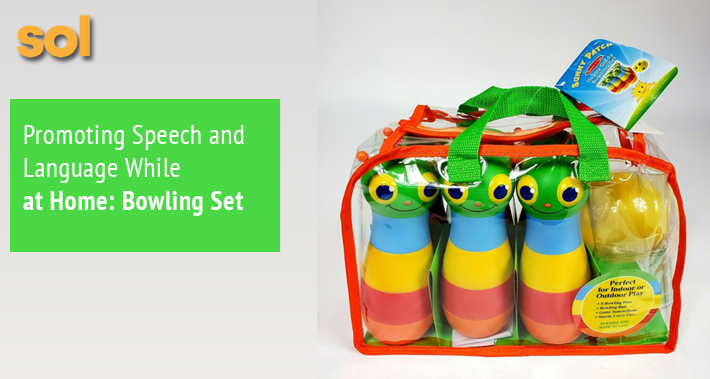
This week in our continued spotlight of a few of Sol’s favorite games/toys to promote speech and language (especially while stuck at home more than usual)…
Happy Giddy Bowling Set
I was first introduced to the Happy Giddy Bowling Set a couple of years ago while working at a speech therapy clinic in Washington DC.
After watching another speech therapist work with a client, I noticed that kids just LOVE to bowl. Plus, it was getting kids moving!
Whether the kiddos were bowling as a reward for great work, or in between practicing correct production of sounds, or just during a language activity, we saw that they had so much fun knocking down pins and could hardly wait for their next turn!
There are plenty of bowling sets out there that you can use, but I was drawn to this set for its fun alien pins, which are great for ages 2-5 years.
However, feel free to use any bowling set you can get your hands on, like this one!
Targets Are Endless While Bowling
Whether at home, at school, or in the clinic here’s how you can use this fun game to promote speech and language:
Receptive Language/Auditory Comprehension:
With this bowling set, you can work on receptive language, specifically, processing oral information and following directions.
Here’s how to use with your client or child:
Following one- and two-step directions is a common goal amongst therapists when working with
clients of all ages. Once the pins have been knocked down, have your child, or client, listen and
then follow directions such as “get two pins” or “get three pins and stand them up over there.”
While bowling, you can ask your kiddo to “knock down 1 pin,” or “knock down the pin in the
front,” which will also incorporate some spatial concepts/prepositions into your directions.
Expressive Language:
If your child or client has a developmental or language delay, with weaknesses in oral expression, you can use this game for a variety of expressive language tasks.
Here are some practical examples:
Before getting a turn, have the child verbally request using a one- or two- word utterance or a
complete sentence, depending on age. For example, a 2-year old may be prompted to use a
two-word utterance such as “my turn” or “more ball.” A 5-year old may be asked to use a
complete sentence or question such as “I want to bowl please” or “Can I have a turn?”
You can also use the bowling pins to encourage use of basic concepts, such as counting the
pins they’ve knocked down/are still standing and/or naming the colors on the pins.
Articulation:
If your child is working on a specific sound, you can practice several trials of that
sound and then allow him/her to take a turn knocking down pins. Go back and forth like this until
you’ve completed all of your trials or words on your list.
Reward:
You can also use bowling as an incentive or reward during a different language activity. For
example, have your kiddo follow directions, use a complete sentence to describe a picture
scene, answer questions, or write a sentence. Then reward them by giving them a turn to
bowl.
We at Sol highly recommend this toy to all our families and fellow therapists!
Don’t forget to check out our other suggestions, like this gem!
Sol has one more great toy up our sleeves.
Can’t wait to share it with you all!
If you live in the Austin and Round Rock areas and have concerns about your child’s speech and/or language and would like to seek additional help beyond what your school based speech pathologist may be able to provide, contact us for more information on our speech and language evaluation and/or speech therapy for kids of all ages.
6448 E Hwy 290 Suite E-108,
Austin, TX 78723
(512) 368-9488
» https://g.page/r/CfRfhOpEQm7BEAE
Sol Speech & Language Therapy
555 Round Rock W Dr E-221,
Round Rock, TX 78681
(512) 808-3953
» https://g.page/r/Cb5pwCTosSEfEBM
Sol Speech & Language Therapy offers personalized skilled intervention to those struggling with their speech and language skills. Services offered include screening, consultation, and comprehensive evaluation. We also provide one-on-one and/or group therapy for speech sound disorders, receptive/expressive language delay/disorder, stuttering/cluttering, accent reduction, and much more.